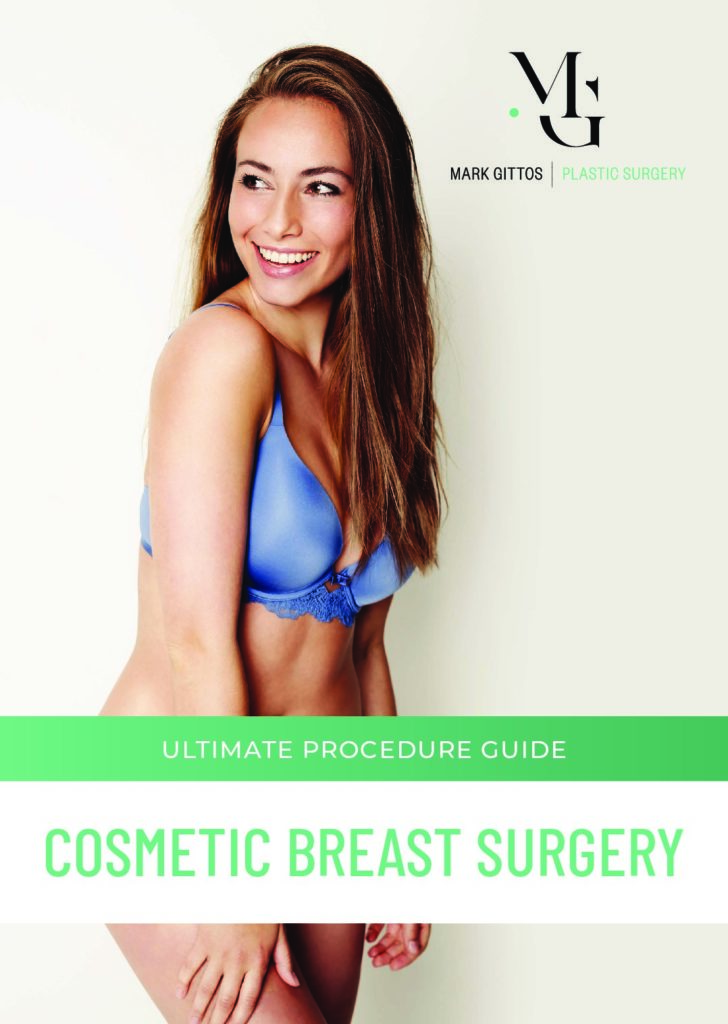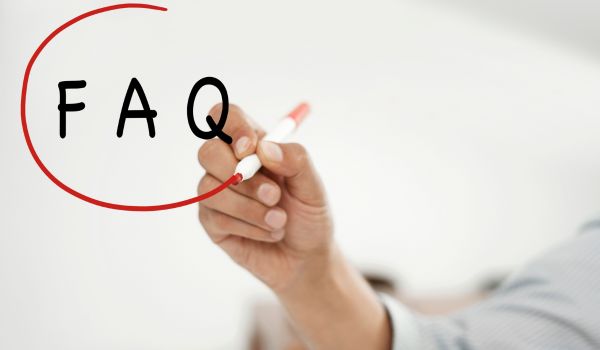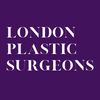Understanding the Normal Healing Process After Breast Augmentation
Breast augmentation surgery can enhance the size, shape, and symmetry of your breasts. Whatever might be the reason why you’re considering this surgery, it’s essential to understand what the recovery process entails. In this blog, we will walk you through the various stages of normal recovery after breast augmentation, provide tips for managing pain and discomfort, and offer insights into long-term results and potential complications. By understanding what to expect and what is normal after surgery, you can better prepare for a smooth recovery.
London Plastic Surgeon Mr Mark Gittos has helped hundreds of patients achieve their desired results with breast augmentation surgery offering guidance through the recovery process.
Download Mr Mark Gittos’ Guide to Cosmetic Breast Surgery

The ABCs of Breast Augmentation Surgery
Breast augmentation surgery involves using breast implants or fat transfer to increase the size of your breasts, improve their shape, or restore volume that has been lost due to ageing, weight fluctuations, or pregnancy. This procedure can also be performed as part of the breast reconstruction process following a mastectomy or injury. Breast augmentation has become increasingly popular over the last decades.
The decision to undergo breast augmentation surgery is a highly personal one, and it’s essential to carefully weigh the potential risks and rewards.
Preparing for Breast Augmentation Surgery
Before you undergo breast augmentation surgery, it’s crucial to prepare both physically and mentally. Your surgeon will provide you with detailed instructions on how to get ready for your procedure, but here are some general guidelines to help you begin the process:
- Choose a qualified plastic surgeon: It’s essential to select a specialist plastic surgeon who has extensive experience in performing breast augmentation procedures. This will help ensure that you receive the highest level of care and achieve the best possible results
- Discuss your goals and expectations: During your consultation, be open and honest with your surgeon about your desired outcome. This will help them create a surgical plan tailored specifically to your needs and preferences
- Quit smoking: If you’re a smoker, it’s crucial to quit at least six weeks before your surgery, as smoking can interfere with the healing process and increase the risk of complications
- Arrange for help during your recovery: You’ll need assistance with daily tasks such as driving, cooking, and childcare for at least the first few days following your surgery. Make arrangements with friends or family members to provide support during this time
Immediate Recovery After Breast Augmentation Surgery
Following your breast augmentation surgery, you’ll likely experience some swelling, bruising, and discomfort. These are normal side effects and will gradually improve as your body heals. Your plastic surgeon will provide you with specific post-operative instructions to follow, such as:
- Rest and sleep: It’s important to get plenty of rest during the first few days after your surgery. Sleep on your back with your head and chest elevated to minimise swelling and promote healing
- Wear a surgical bra or compression garment: Your plastic surgeon will likely provide you with a special bra or compression garment to wear during the initial stages of recovery. This will help support your breasts, minimise swelling, and ensure that your implants settle into the correct position
- Take prescribed medications: Your plastic surgeon will likely prescribe pain medications and antibiotics to manage discomfort and prevent infection. Be sure to take these medications as directed, and don’t hesitate to contact your surgeon if you have any concerns about your pain levels or side effects
Managing Pain and Discomfort During Recovery

Pain and discomfort are common after breast augmentation surgery, but there are several strategies you can employ to help manage these symptoms:
- Follow your surgeon’s instructions: Adhering to your surgeon’s post-operative guidelines is essential for minimising pain and ensuring a smooth recovery. This may include wearing a surgical bra, taking prescribed medications, and avoiding certain activities
- Use ice packs: Applying ice packs to your breasts can help reduce swelling and alleviate discomfort. Be sure to wrap the ice pack in a cloth or towel to protect your skin and avoid applying ice directly to your incisions
- Practice gentle exercises: Once your surgeon gives you the green light, begin incorporating gentle exercises into your daily routine to help alleviate stiffness and promote circulation. This may include arm circles, shoulder rolls, and neck stretches. Always consult your surgeon before starting any new exercise regimen
Post-Operative Care and Precautions
Proper post-operative care is essential for ensuring a successful recovery after breast augmentation surgery. Here are some precautions to keep in mind during the healing process:
- Keep your incisions clean and dry: Your plastic surgeon will provide you with instructions on how to care for your incisions, which may include cleaning them with a mild soap and water and applying an antibiotic ointment. It’s important to follow these guidelines to reduce the risk of infection
- Avoid heavy lifting and strenuous activities: For at least the first few weeks following your surgery, you’ll need to refrain from activities that could strain your chest muscles or compromise your incisions. This includes lifting heavy objects, engaging in high-intensity exercise, and participating in contact sports
- Attend follow-up appointments: Your plastic surgeon will schedule several follow-up appointments to monitor your progress and ensure that you’re healing properly. Be sure to attend these appointments and address any concerns or questions you may have
Stages of the Healing Process After Breast Augmentation
The healing process after breast augmentation surgery can be broken down into several stages:
- Immediate post-operative period (first few days): During this time, you may experience swelling, bruising, and discomfort, which can be managed with prescribed medications and ice packs. It’s important to get plenty of rest and wear your surgical bra or compression garment as directed
- Early recovery (first few weeks): As the initial swelling and bruising begin to subside, you’ll start to see the results of your surgery. You may still have some restrictions on your activities, but you’ll likely be able to resume most of your normal daily tasks
- Mid-recovery (several weeks to a few months): During this stage, your implants will continue to settle into their final position, and your incisions will begin to fade. You’ll likely be able to resume more vigorous activities, but be sure to consult your surgeon before doing so
- Long-term recovery (several months to a year): By this point, your breasts should have fully healed, and you’ll be able to enjoy the full benefits of your breast augmentation surgery. Keep in mind that your implants may require maintenance or replacement in the future, so it’s important to continue attending follow-up appointments with your surgeon
Common Complications and How to Avoid Them
While breast augmentation surgery is generally considered safe, there are potential complications that can arise. Some of the most common complications include infection, bleeding, changes in nipple or breast sensation, implant rupture or leakage, and capsular contracture (a hardening of the scar tissue around the implant). To reduce your risk of these complications, be sure to:
- Choose a qualified plastic surgeon: Selecting a specialist plastic surgeon with extensive experience in breast augmentation procedures is essential for ensuring the highest level of care
- Follow your surgeon’s instructions: Adhering to your surgeon’s pre- and post-operative guidelines will help minimise the risk of complications and support a successful recovery
- Maintain a healthy lifestyle: Eating a balanced diet, exercising regularly, and avoiding smoking can help promote healing and reduce the risk of complications
Long-Term Recovery and Results
Breast augmentation surgery can provide long-lasting results, but it’s important to remember that your implants may require replacement in the future. Regular follow-up appointments with your surgeon will help ensure that your implants remain in good condition and that any potential issues are addressed promptly.
Maintaining a stable weight, practicing good skin care, and wearing a supportive bra can also help prolong the life of your implants and maintain the appearance of your breasts. By taking these steps and staying in close communication with your surgeon, you can enjoy the benefits of your breast augmentation surgery for years to come.
Tips for a Smooth and Successful Recovery
- Educate yourself: Understanding the breast augmentation surgery process and what to expect during recovery can help alleviate anxiety and promote a more successful healing experience
- Stay organized: Keep track of your surgeon’s instructions, medications, and appointments to ensure that you stay on track during your recovery
- Ask for help: Don’t hesitate to lean on friends and family members for support during your recovery, whether it’s assistance with daily tasks or emotional encouragement
- Be patient: Healing takes time, and it’s important to be patient with yourself during the recovery process. Avoid comparing your progress to others and focus on listening to your body and following your surgeon’s instructions
- Take care of yourself: In addition to rest and recovery, be sure to practice self-care during this time. This may include eating a healthy diet, staying hydrated, getting fresh air and sunlight, and engaging in relaxing activities like meditation or gentle yoga
FAQs about Normal Recovery after Breast Augmentation

How long should I take off work after breast augmentation?
- The amount of time needed off work after breast augmentation surgery will depend on several factors, including the type of work you do and the complexity of the surgery. In general, most patients can return to work within two weeks after surgery, but it is important to avoid heavy lifting, strenuous activity, and any activities that put stress on the chest muscles for several weeks after surgery. Your plastic surgeon can provide specific guidelines based on your individual situation.
What to expect 4 weeks after breast augmentation?
- At four weeks after breast augmentation, most patients will have significantly reduced swelling and discomfort. The incisions should be well-healed, and the implants should have settled into position. Patients can return to most normal activities at this point, but should still avoid any heavy lifting or strenuous exercise for a few more weeks.
How long does it take for breasts to look normal after augmentation?
- It can take several months for the breasts to fully settle into their final position and for the swelling to completely resolve after breast augmentation surgery. However, patients should see noticeable improvement in the appearance of their breasts within the first few weeks after surgery. Your plastic surgeon can provide specific information about the timeline for your individual recovery.
What is the fastest way to recover from breast augmentation?
- The best way to ensure a smooth and speedy recovery from breast augmentation surgery is to follow your surgeon’s post-operative instructions carefully. This may include wearing a supportive bra, avoiding strenuous activity, getting plenty of rest, and taking any prescribed medications as directed. It is also important to maintain a healthy diet and stay hydrated to promote optimal healing.
How painful is recovery from breast augmentation?
- Most patients experience some discomfort and soreness after breast augmentation surgery, which can be managed with pain medication and rest. The level of pain and discomfort will vary depending on the extent of the surgery and the individual’s pain tolerance. Most patients are able to manage their pain with medication for the first few days after surgery, and then switch to over-the-counter pain relief as needed.
Further Reading about Normal Recovery and Breast Augmentation Surgery
- Read Mr Mark Gittos’ Breast Augmentation Surgery Page
- Read Mr Mark Gittos’ Breast Implant Options Page
- Read Mr Mark Gittos’ Recovery after Surgery Page
- Read Mr Mark Gittos’ Smoking and Surgery Page
- Read Mr Mark Gittos’ Blog about How to Improve your Recovery After Breast Augmentation
Medical References about Recovery after Breast Augmentation Surgery
- How long is the recovery for a breast augmentation? | ASPS
- Breast augmentation recovery – what you need to know | ASPS
- Breast enlargement (implants) – NHS
- Breast augmentation – Mayo Clinic
About Mr Mark Gittos FRACS (Plast) – London Plastic Surgeons
Practice locations in London & Essex, UK and Auckland, New Zealand.
Mr Mark Gittos offers high quality, natural-looking cosmetic surgery results and is highly experienced in Breast, Body and Face Surgery having performed over 4000 Surgeries in the last 26 years.
With world-wide expertise Mr Gittos is an expert in breast, face and body surgery for men & women.
Mr Mark Gittos is a leading Specialist Plastic Surgeon and operates a practice in London UK and Auckland New Zealand. His practice focuses on both surgical and non-surgical procedures, each designed to help restore, improve or change a physical characteristic or problem. The first step in every case is to talk through your personal requirements and explore all the options, before deciding on the most effective solution.
Naturally, before any treatment is begun, we will explain clearly the advantages and risk factors; so that you have the information you need to make an informed decision that is best for you. Visit the practice to find out more.

NEXT STEPS
Do your Research
- Read the Website and Blogs relevant to your procedure
- Browse our Frequently Asked Questions including how to choose a Surgeon for your procedure
- Download the Guides to Surgery
What to Bring to your Plastic Surgeon Consultation
- Bring a friend or relative to help discuss the information and your choices
- Take lots of notes and read the documents provided thoroughly
- Want more information before scheduling your consultation?
Book your Initial Surgery Consultation
- A Referral from your GP or specialist is helpful but NOT essential – you can have a consultation without a GP Referral
- Email us or Call in London on 07557 858156 to arrange your surgeon consultation appointment.
- Book a consultation with Mr Gittos by paying the Consultation Fee
Please contact us to arrange to book a consultation with our Specialist Plastic Surgeon or to speak with our Patient Care Advisor.
Send an enquiry form today or UK phone 07557 858156 during Clinic Hours
